Ever since I learned about the health benefits of broth I wanted to get more into my diet. It’s just not that easy. Homemade broth takes time to prepare, has a limited shelf life, can be difficult to freeze (in glass), and takes a lot of freezer space. Dehydrating broth to make broth cubes solves many of these challenges, but I’ve found something even better.
Before we get into the specifics of dehydrating broth let’s see why we would make the effort. Take a look at what daily consumption of broth provides1;
- protein, although not a complete protein it does reduce the body’s need for complete proteins
- nutrient dense dissolved bone marrow
- cartilage building glycine, proline, glutamine, and proteoglycans
- high collagen content for building bones
- glycine, conditionally essential for blood, fat digesting bile, and detoxifying glutathione
- glutamine* conditionally essential for rebuilding cells in the gut
- alanine for endurance
*Long (6-24hrs) cooked broth can have triple the level of glutamine which individuals sensitive to MSG can react to. Those with sensitivity to MSG should start with lightly (1-3hrs) cooked broth if tolerated.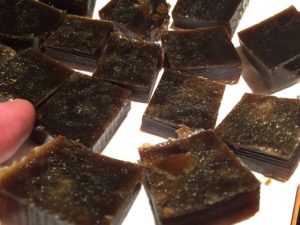
Okay, so we can agree it’s a nutritional powerhouse but for the reasons mentioned previously it’s not so easy to get. When I came across a post by Nourished Kitchen on Portable Soup, it piqued my interest. It sounded like a potential solution to my problem. The portable soup is basically homemade broth that is reduced by boiling to a syrup and then allowed to cool and harden to a very stiff Jell-O like consistency. It is then cut into cubes, stored in the refrigerator, and used like bouillon cubes.
I gave this a try a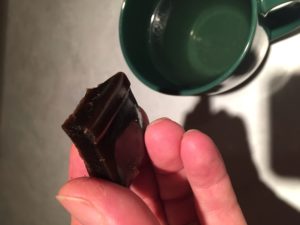 nd found it quite effective but ran into a few problems. First it’s a bit time-consuming to cut and deal with all the 1” cubes. Second, after a week or two the cubes began to mold even though stored in the refrigerator. Using vegetables in the broth can contribute to mold in dehydrated broth but I didn’t use vegetables and mine still molded. Freezing would seem an obvious solution but freezing 1 inch cubes requires wrapping them all separately which is again quite time-consuming.
nd found it quite effective but ran into a few problems. First it’s a bit time-consuming to cut and deal with all the 1” cubes. Second, after a week or two the cubes began to mold even though stored in the refrigerator. Using vegetables in the broth can contribute to mold in dehydrated broth but I didn’t use vegetables and mine still molded. Freezing would seem an obvious solution but freezing 1 inch cubes requires wrapping them all separately which is again quite time-consuming.
So here’s the solution I developed and it’s working great. Begin by making your broth and remember to leave out the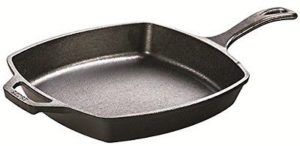 vegetables. Once the broth is complete cool it overnight in the refrigerator so you can skim the fat off the top of the broth. Now reduce the broth by boiling away the water content.
vegetables. Once the broth is complete cool it overnight in the refrigerator so you can skim the fat off the top of the broth. Now reduce the broth by boiling away the water content.
I use two Lodge L8SQ 10.5-inch cast iron pans. I bought these specifically to maximize surface area for the purpose of minimizing the “boil-down” time. These two pans hold 14 cups of broth (7 cups each) and can reduce 1-1/2 gallons of broth to a syrup consistency in about 1 hour. Somewhere between a rolling boil and simmer is just the right temperature. Stir occasionally and more frequently as the broth reaches syrup consistency.
When the broth pours off a spoon like thick maple syrup you’re done reducing the broth. Remove it from heat and carefully pour or ladle it off into Ball Mason 4oz Quilted Jelly Jars. Let cool in the refrigerator overnight without lids. The next day screw on lids and place in the freezer. These jars are freezer safe.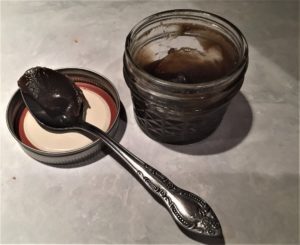
To enjoy your daily broth just move a jar from the freezer to the refrigerator the night before you’ll need it. To make a cup of broth just spoon out a heaping teaspoon and dissolve in a cup of boiling water. One jelly jar should make about 7 cups of broth.
Now there’s no excuse not to have your daily broth. Go forth and drink broth!
1 Fallon, Sally, Kaayla T. Daniel, and Mary Woodin. Nourishing Broth: An Old-fashioned Remedy for the Modern World. New York: Grand Central Life & Style, 2014. Print.
- Dehydrated Broth – Making It Easy to Drink Broth Every Day! - March 11, 2017
- Lose 10 lbs DURING the Holidays - November 19, 2016
- Finding Good Oils - February 7, 2016


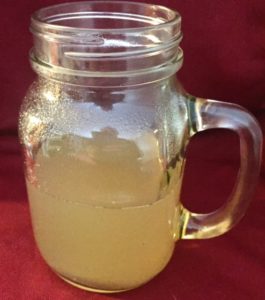
No comments yet.